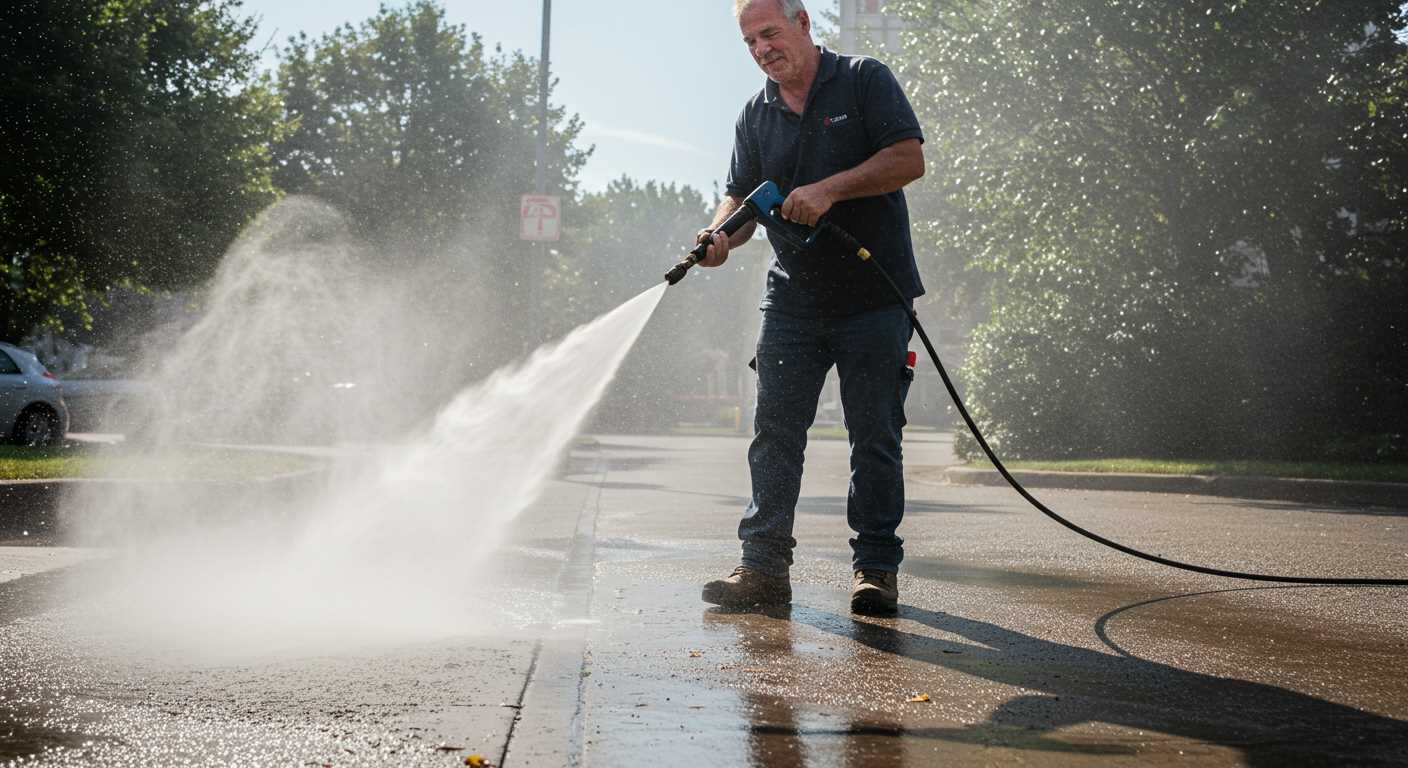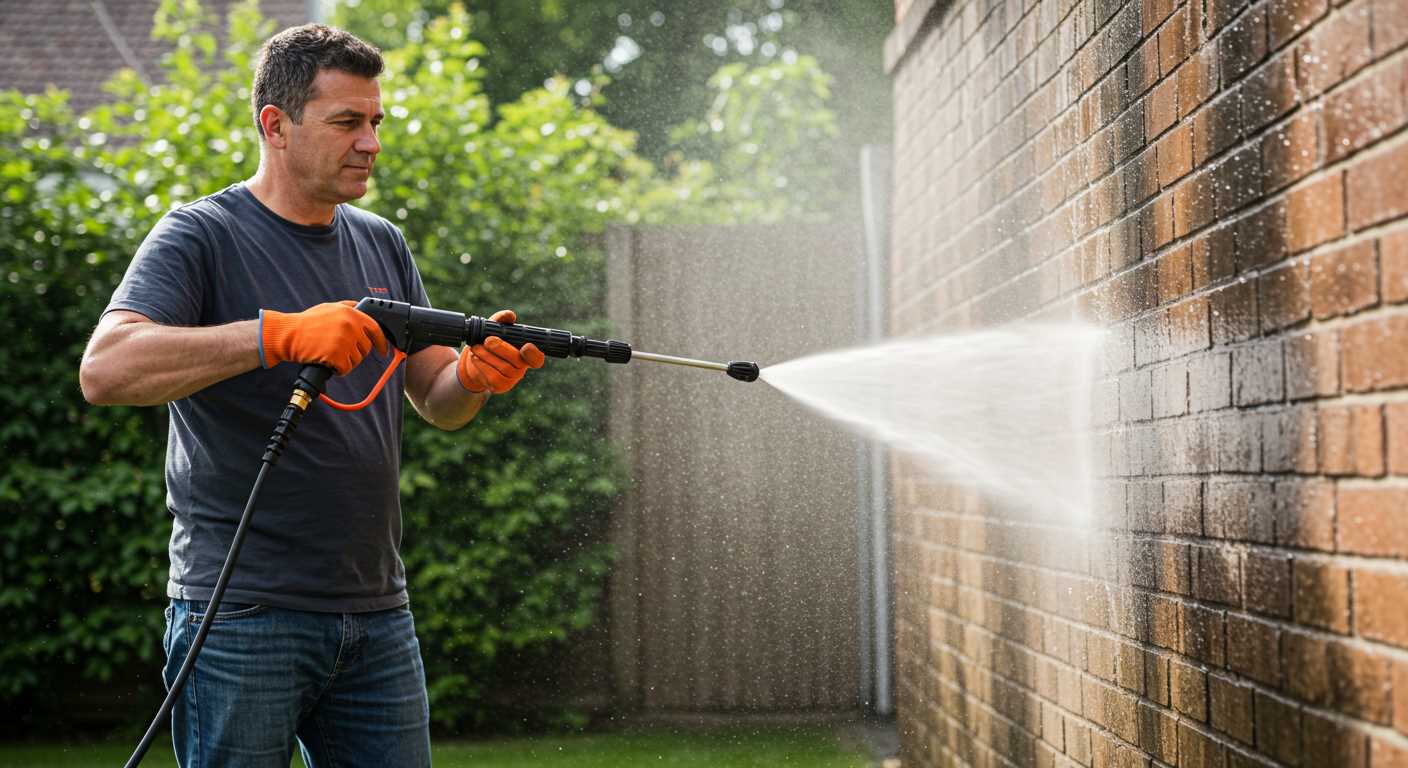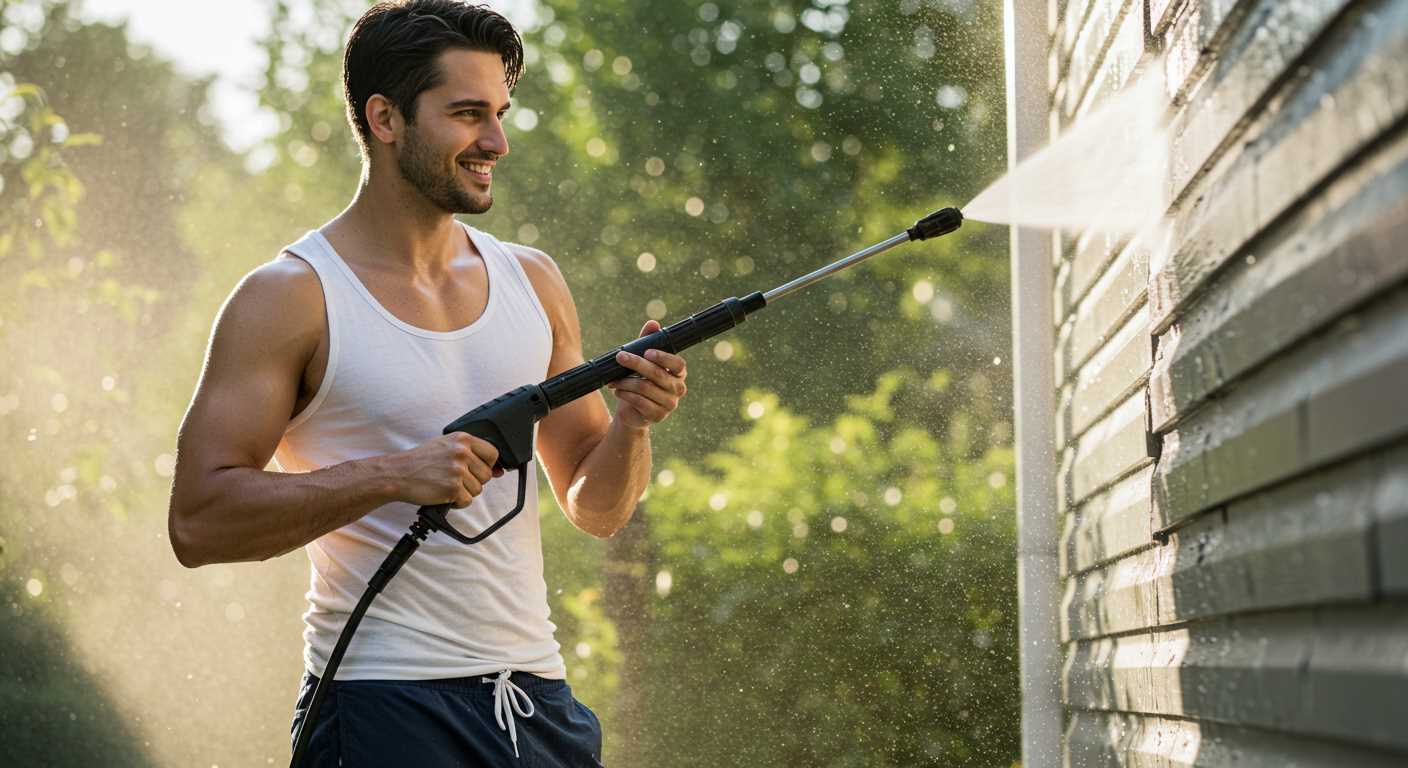



Begin by selecting a unit that delivers at least 2500 PSI for outstanding results. This power level effectively removes stubborn stains, dirt, and moss, restoring the appearance of your outdoor space without damaging the surface.
Prior to operation, ensure to clear any loose debris such as leaves or rocks. A clean area will not only enhance the effectiveness of your efforts but also prevent any obstructions during the process.
Next, apply a suitable cleaning solution tailored for porous materials. Allow the formula to penetrate the grime for a few minutes before using the high-pressure device. This pre-treatment amplifies the efficiency of the subsequent washing stage.
When utilising the equipment, maintain an appropriate distance of around 12 inches from the surface. Start at one corner and work systematically across the area, employing sweeping motions to ensure consistent coverage. This technique minimises the risk of etching the surface while achieving a thorough cleanse.
After rinsing, inspect for any residual marks or stains. For areas requiring further attention, consider repeating the treatment or using a detailed cleaning attachment to focus on specific spots. Conclude by allowing the surface to dry completely to prevent slipping hazards in wet conditions.
Employing these methods not only rejuvenates your paved surface but also prolongs its lifespan, making it an investment worth undertaking.
Effective Techniques for Driveway Restoration
Begin by ensuring you have the appropriate equipment for the task. Opt for a model that offers adjustable pressure settings, ideally between 1500 to 3000 PSI, for optimal results. A rotary nozzle can also be particularly beneficial.
Follow these steps for a thorough process:
- Prepare the Area: Clear the surface of any debris, such as leaves or stones. Identify areas with heavy staining or moss.
- Apply Detergent: Utilize a suitable cleaning agent specifically designed for porous surfaces. Attach the detergent bottle to the machine and apply it evenly across the area, allowing it to dwell for the specified time on the product label.
- Adjust Pressure: Switch to a higher setting, if necessary. Maintain a distance of around two feet from the surface to prevent damage.
- Start Pressure Application: Move the nozzle in a sweeping motion, overlapping each pass slightly. Tackle the most soiled areas systematically.
- Rinse Thoroughly: After the cleaning solution has had sufficient time to act, switch to a wide-angle nozzle and rinse the surface thoroughly to remove all residues effectively.
- Assess and Repeat: Inspect the area once it’s dry. Any remaining stubborn stains might require targeted treatment or a second application.
- Seal If Needed: Consider applying a sealant after thorough drying to enhance longevity and make future maintenance easier.
By following these methods, the restoration of your surface will be significantly improved, allowing for an appealing appearance and extended lifespan.
Choosing the Right Pressure Washer for Your Brick Driveway
Opt for a unit with a minimum pressure of 2,000 PSI to effectively tackle stubborn stains and grime. Machines delivering adjustable pressure settings are ideal, allowing you to fine-tune the output based on the surface condition and type of dirt.
Look for a model featuring a wide spray nozzle range. A 15-degree nozzle works wonders for heavy buildup, while a 25-degree option is suitable for lighter tasks. Detachable nozzles offer flexibility in tackling varying levels of dirt.
Consider machines equipped with a detergent tank. This simplifies the cleaning process, allowing the use of specialised cleaning solutions designed to enhance results without damaging the surface beneath.
Evaluate the flow rate, expressed in litres per minute (LPM). A higher flow rate, ideally above 8 LPM, helps remove debris more efficiently, cutting down on the time spent on the task.
Assess the unit’s portability and weight. For residential settings, a lightweight model with wheels is preferable, enabling easy manoeuvrability around the area. Sturdy construction materials ensure longevity, vital for regular use.
Finally, pay attention to the manufacturer’s reputation. Brands with a track record of reliability and customer support can provide peace of mind and assistance when needed. Personal experiences and user reviews often reveal insights into performance and durability.
Preparing Your Brick Driveway for Cleaning
Clear the area of any obstacles. Remove vehicles, furniture, garden equipment, and debris to allow full access to the surface. This will prevent blockages during the cleansing process.
Inspect and Repair Any Damage

Examine the surface carefully for cracks or loose elements. Repair any damaged sections before beginning the washing process. Use appropriate masonry filler or adhesive as needed to ensure integrity during treatment.
Gather Necessary Supplies
Collect essential items: a sturdy broom for sweeping up loose dirt, protective eyewear to shield your eyes from debris, gloves for hand protection, and a suitable nozzle for the power cleaning tool. Having these at hand will streamline your efforts.
Selecting the Appropriate Nozzle for Pressure Washing

Choose between different nozzle types for optimal results. The most recommended for tough surfaces is the 0-degree nozzle, providing a focused stream for removing stubborn stains. However, use it cautiously to prevent damage, especially on softer materials.
The 15-degree variant is a versatile option, effective for heavy-duty tasks while minimizing potential harm. It strikes a balance between power and safety, making it ideal for most applications.
For lighter dirt and residue, the 25-degree tip suffices. It covers a broader area, ensuring quicker progress for general maintenance. This selection is perfect for more delicate surfaces, where excessive force is unnecessary.
The 40-degree nozzle provides a gentle spray, suited for broad cleaning needs like patios and decks. It is excellent for rinsing off loose debris without heavy pressure.
Consider adjustable nozzles as they offer flexibility. They allow users to switch between different spray patterns without the hassle of changing tips. This can save time and effort during the process.
Always remember to test on a small, inconspicuous area before proceeding with any cleaning task. This practice guarantees that the selected nozzle will not cause damage to the surface being treated.
Maintaining your nozzles is crucial; cleaning them regularly ensures consistent performance and longevity. Store them in a dry place to prevent clogging and wear.
Applying Detergent for Stubborn Stains on Brick
For tough blemishes, using an appropriate cleaner makes a significant difference. I recommend selecting a detergent specifically designed for heavy-duty tasks. Ensure it is safe for the surface materials to avoid damage.
Choosing the Right Detergent
Look for formulations that target grease, oil, mould, and mildew. Non-toxic and biodegradable options often provide effective results while being environmentally friendly. Read the label carefully to determine suitability.
Application Method

Before applying the detergent, mix it according to the manufacturer’s instructions. Using a garden sprayer or a low-pressure nozzle attached to the equipment facilitates even coverage. Start from the top and work your way down, allowing the cleaner to sit for approximately 10-15 minutes to break down the stains.
Afterward, rinse the area thoroughly to remove any remaining residue. This will help to maintain the integrity of the surface while restoring its appearance.
For exceptionally stubborn spots, a second application might be necessary. Reassess the stained areas post-rinse, and if needed, repeat the process to achieve the desired look.
Techniques for Pressure Washing Brick Driveway
Begin at a corner and work your way towards an exit. This prevents walking over cleaned areas, which could leave marks or require additional effort. Maintain a consistent distance of approximately 12-18 inches from the surface, adjusting as necessary based on the surface condition and the equipment’s power.
Utilise a sweeping motion rather than a direct spray to avoid damaging the surface. Move the nozzle in overlapping passes, ensuring complete coverage and preventing striping or uneven cleaning. Start with lower pressure settings to evaluate how the surface responds before increasing pressure if needed.
Pay particular attention to seams and grout between pavers. Angling the nozzle at 30 to 45 degrees will help dislodge dirt trapped in these areas effectively. Avoid staying in one spot for too long to prevent etching into the material.
For better results, rinse area after applying detergent. This helps to remove any residues and prevents streaking. If using an attachment for surface cleaning, keep it steady while moving to achieve an even finish, reducing time spent on repetitive motions.
Lastly, consider weather conditions; dry surfaces can absorb stains more readily. For ideal results, choose a cooler day with a slight breeze to assist in drying and enhance the effectiveness of detergents.
Dealing with Weeds and Algae During the Cleaning Process
Addressing unwanted vegetation and slimy growth is critical in restoring a surface’s appearance. Begin by manually pulling out any visible weeds. This initial step ensures that your equipment doesn’t just spray over these issues, leading to short-term results.
Preventing Future Growth
After removing the weeds, consider applying a broad-spectrum herbicide to eliminate any remaining root systems. Choose a product that targets both grasses and broadleaf weeds. Follow the manufacturer’s guidelines for application rates and safety precautions.
- Opt for a systemic herbicide that penetrates the plant’s tissues.
- Time your application during dry weather for maximum effectiveness.
- Allow a few days for the herbicide to take effect before rinsing the area.
Tackling Algae and Moss
For algae and moss, a dedicated cleaner is necessary. Formulations with bleach or other algae-fighting agents can be particularly effective. Apply the solution generously and let it soak in for at least 15-20 minutes before rinsing.
- Identify affected areas by looking for slippery patches or discolouration.
- Test the cleaning solution on a small section to ensure it won’t cause discoloration.
- Systematically apply the cleaner with a sprayer or watering can, avoiding plants nearby.
Follow up with thorough rinsing using your equipment. A hot water option may enhance the cleaning power against stubborn remnants. Monitor the area regularly to catch regrowth early.
Rinsing and Inspecting Your Brick Driveway After Cleaning
Thorough rinsing follows the washing phase, ensuring all detergent residue is removed. Employ a wide-angle nozzle to cover more surface area effectively. Start from one end and move systematically to the other. Maintain a consistent distance of around 12 inches from the surface to ensure safety and prevent damage. Consider rinsing in sections to confirm that no soap lingers, which can lead to slippery conditions.
After rinsing, take a moment to inspect the surface for any stubborn spots or stains that might not have been removed during washing. Pay particular attention to junctions and edges where grime tends to accumulate. If you find any remnants, a targeted application of detergent at those areas followed by spot rinsing may be necessary.
In addition to checking for stains, evaluate the integrity of the mortar between the units. Look for any cracks or erosion that could indicate underlying issues. Addressing these concerns early can prevent more significant problems down the line, ensuring your exterior remains visually appealing and structurally sound.
| Inspection Item | Action Required |
|---|---|
| Stubborn stains | Apply targeted detergent and rinse |
| Mortar condition | Repair cracks or eroded areas |
| Surface slickness | Ensure thorough rinsing; consider using sand |
Final checks should include assessing overall cleanliness and ensuring no objects have been left behind, which could cause issues later. A well-rounded inspection guarantees a maintained appearance and extends the lifespan of your surface. Regular upkeep and prompt attention to small concerns will contribute to long-lasting results.
Sealing Your Brick Driveway for Long-Term Maintenance
Apply a high-quality sealer after completing the washing process to protect against moisture and stains. Choose a water-based, breathable sealer designed specifically for outdoor surfaces. This will ensure the material retains its integrity while allowing for necessary ventilation to prevent trapped moisture.
Before applying the sealant, ensure the surface is completely dry. This means waiting at least 24 hours following the cleaning to allow sufficient evaporation of any moisture. Use a moisture meter if available for more precise readings.
Utilise a roller or sprayer to achieve a uniform application. Start at one corner and work your way across, maintaining a wet edge to avoid lines. It’s wise to apply two coats for optimal protection. Allow the first coat to dry for the time specified by the manufacturer before proceeding with the second.
Schedule annual inspections for wear and reapply the sealing product as necessary. Taking proactive measures will not only enhance appearance but also prolong the lifespan of your installation, preventing future costly repairs.
Finally, avoid heavy vehicle traffic for at least 48 hours after sealing, as this period allows the finish to cure effectively and adhere properly to the surface, ultimately delivering the best results.









